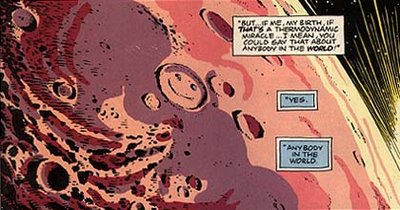Alas, due to the recent heat wave, and a desire to eschew all serious topics (and to spur a long-distance book club discussion with Eric) I once again revisit my "All Time Best" List.
All Time Best Graphic Novel.
The Watchmen by Alan Moore and illustrated by Dave Gibbons.

There are many, many websites dedicated to deconstructing The Watchmen, a graphic novel which is in itself a masterful deconstruction of the superhero genre. I will assume the of the few of you who read this blog, most of you don't have any idea what it's about. I highly recommend picking up a copy, and read it spoiler free, before you go a-web surfing. I won't spoil the story in this blog.
To many, the Watchmen represents a sea-change in the comic book world. It, along with Frank Miller's The Dark Night Returns, is often mentioned as ushering the comics into the new millennium. No longer would the medium be just relegated to children's stories and weekend newspaper funnies. The Watchmen proved that comics could tell a complex, smart, sophisticated and truly engaging tale. It is a truly "adult comic" ("adult" in the sense of mature, and not how it's usually interpreted, i.e. "pornographic"). Again, I invite you to get a copy, because I won't even try discussing the story here. As a martial artist, what I do want to discuss is technique. Specifically the technique involved in writing the graphic novel.
Again, The Watchmen is proof that both Alan Moore and Dave Gibbons are master's of the medium. It can be enjoyed on many different levels, meaning you can read it over and over and still be granted new ephiphanies.
Level 1) The Forest: The novel has a very noir feel. Images and languages work together to invoke feelings one would get watching a Hitchcock film, or reading Raymond Chandler. Just look at this panel from page 8 of issue 1.
 This wordless introduction to a key character presents all you need to know about this mysterious person. There is nothing thrown away here. The first panel alone communicates the key theme of the whole enterprise. Each panel is as dutifully composed as each frame in a Kubrick film.
This wordless introduction to a key character presents all you need to know about this mysterious person. There is nothing thrown away here. The first panel alone communicates the key theme of the whole enterprise. Each panel is as dutifully composed as each frame in a Kubrick film.A true indication of the novels influence on today's culture can be seen in the opening pages of issue 1. The "pull-back" technique has been used again and again to in opening shots of films like "Men In Black" and "Contact".
Level 2) The Trees: The panels are loaded with details and clues that help outline the plot. Upon the first read, the ever-unfolding revelations will pretty much take your breath away. But what will really blow your mind is upon the second read, you discover that the drawing were full of clues that pre-state these revelations.

Level 3) The Language of Dreams: One of the key techniques Alan Moore would use to transcend the perception that comics had no literary merit, was to employ the use of repeated symbols, which was inspired by the writing of Willam Burroughs. For example, the "smiley face" symbol from issue 1... ... is repeated again
... is repeated again  and again
and again  throughout the novel, most notably in issue 9...
throughout the novel, most notably in issue 9...
 ... is repeated again
... is repeated again  and again
and again  throughout the novel, most notably in issue 9...
throughout the novel, most notably in issue 9...The effective use of repetition with the novels text creates a dream-like sub language throughout the novel. This sub language is unique to the comic medium, unable to be achieved through the sole use of either cinema or literature. The reader's subconscious mind is interpreting images, and creating evocative linkages with the text. This explains the haunting nature of the work, as well as it's continued relevance to our society despite being 20 years old.
Again, martial artists can find enjoyment of the novel through the appreciation of technique. You get a sense of the work required to create this opus, the countless hours of grinding away all the waste to produce a truly extraodinary and lasting piece of art. You also appreciate how the medium requires it's own language, it's own unique way of communicating that allows the practitioner to communicate something to the audience. It provides inspiration for us who attempt to express ourselves through the martial arts.






3 comments:
Here are some links that I believe will be interested
I like it! Keep up the good work. Thanks for sharing this wonderful site with us.
»
Nice Blog, Ali...and darn you, you're making me dig out my copy of Watchmen.
I never knew we had so much in common...I'm loving your all time best lists.
Between your taste in anime, books (read: Dark Tower), and comics, you're doing pretty good so far.
Some thingsto consider:
All time best Sci-fi (movies and TV shows)
All time best toyline
All time best anime
all time best cartoons (american)
The site needs more TSD, though.
Like I should talk, Ineed towrite something new on the subject myself. the lastthing I wrote is this (almost2 years ago now):
http://www.karateforums.com/viewtopic.php?t=19067
Hope allis going well with you and Teresa.
Tang Soo!
Post a Comment